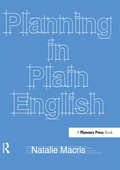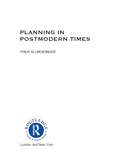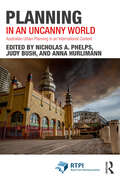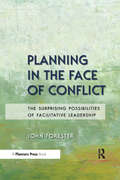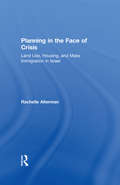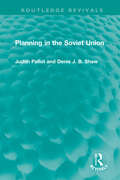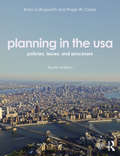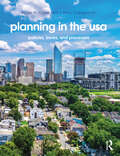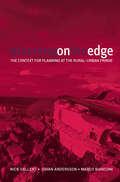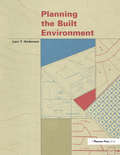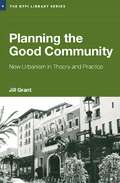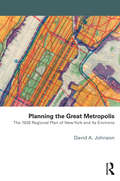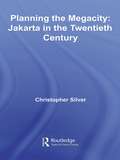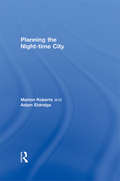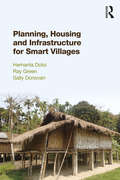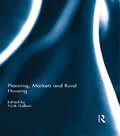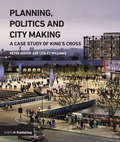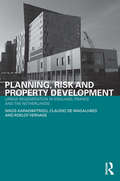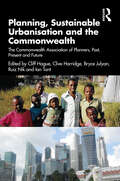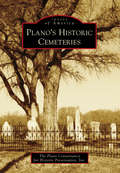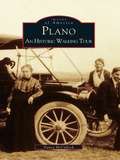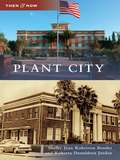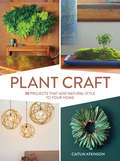- Table View
- List View
Planning in Plain English: Writing Tips for Urban and Environmental Planners
by Natalie MacrisIn this volume, the author draws from more than a decade of editing experience to explain how to craft clear, understandable, and highly readable planning documents. The author suggests ways to overcome planners' most common writing foibles: acronymns, jargon, and overuse of the passive voice. And the author provides handy lists to transform mushy nouns into powerful verbs, pare down bloated sentences, and translate ""bureaucratese"" into everyday language. The author even includes practice exercises designed to help you recognize and overcome bad writing habits. But even the best writing skills won't help if your document is organized poorly and aimed at the wrong audience.The author also explains why it's essential to know who your readers are before you start writing and how to organize your work so that it will be easy to understand and use."
Planning in Postmodern Times (RTPI Library Series)
by Philip AllmendingerPostmodern social theory has provided significant insights into our understanding of society and its components. Key thinkers including Foucault, Baudrillard and Lyotard have challenged existing ideas about power and rationality in society. This book analyses planning from a postmodern perspective and explores alternative conceptions based on a combination of postmodern thinking and other fields of social theory. In doing so, it exposes some of the limits of postmodern social theory while providing an alternative conception of planning in the twenty-first century.This title will appeal to anyone interested in how we think and act in relation to cities, urban planning and governance.
Planning in an Uncanny World: Australian Urban Planning in an International Context (RTPI Library Series)
by Nicholas A. Phelps Judy Bush Anna HurlimannThis book places Australian conditions and urban planning centrally within comparative analysis of planning systems and cultures around the world to address issues including urban governance, climate change, transportation planning, regional development and migration planning. Australian urban conditions and their associated planning responses can and often have been seen as unique or exceptional. They are seldom discussed in the same breath as conditions and associated planning systems internationally. Yet, as well as being somewhat different from those elsewhere in the world, Australian urban conditions and planning responses are also somewhat similar. They are uncanny – strangely familiar yet unfamiliar. In this book, Australian urban conditions, and their planning policies and practices are informally compared and contrasted with those existing internationally. If Australian urban planning policy and practice have had limited influence internationally, the partial familiarity of challenges posed by its urban conditions ensure that Australia is a more important global reference point for scholarship and practice than commonly is appreciated. In this book the authors assert the potential and actual originality of urban planning scholarship arising from the Australian context. It will be useful for students and faculty, planners working in Australia, as well as anyone interested in international planning debates.
Planning in the Face of Conflict: The Surprising Possibilities of Facilitative Leadership
by John F ForesterBikers and hikers. Sex workers and social conservatives. Agencies and activists. The people involved in planning for a site—or a community—can be like the Hatfields and McCoys. And the process brings them together face to face and toe to toe. How can planners take conflicted communities from passionate demands to practical solutions? Facilitative leadership offers helpful answers. Cornell University’s John Forester has produced a dozen profiles of planning practitioners known for their successes in helping communities turn contentious conflicts into practical consensus. This remarkable book tells their stories in their own words. Lisa Beutler shows the way she got California’s off-highway vehicle users and recreationists on the same track. Michael Hughes shares the search for common ground for HIV prevention in Colorado. Shirley Solomon recalls how lessons learned in South Africa helped her build trust between Native Americans and county officials in the Pacific Northwest. Forester and his panel of experts offer no simplistic formulas but a great deal of practical guidance. From mind mapping to the Hawaiian concept of Ho’ oponopono (making things right), readers will come away with a wealth of ideas they can use to move from the heat of confrontation to the light of creative solutions in their communities.
Planning in the Face of Crisis: Land Use, Housing, and Mass Immigration in Israel (Cities And Regions Ser.)
by Rachelle AltermanCritics of urban and regional planning argue that it is best suited to manage incremental change. Can a planner's skills and expertise be effective in handling a major crisis and large-scale change? The mass immigration from the former Soviet Union to Israel in the 1990s offers the opportunity to study one of the largest-scale (non-disaster) crisis situations in a democratic, advanced-economy country. This book recounts the fascinating saga of how policymakers and planners at both the national and local levels responded to the formidable demand for housing and massive urban growth. Planners forged new housing and land-use policies, and applied a streamlined (but controversial) planning law. The outputs were impressive. The outcomes and impacts changed the landscape and human-scape of Israel, heightening dilemmas of land use and urban policy in this high-density country.
Planning in the Soviet Union (Routledge Revivals)
by Judith Pallot Denis J. ShawOriginally published in 1981 and based on the authors’ own research, this book provides a comprehensive review of planning in the Soviet Union up until the early 1980s for both geographers and Soviet specialists. Planning was particularly important in the Soviet Union since not only most spatial change, but all economic planning was the product of a systematic socio-political ideology. Planning was therefore the key to understanding the Soviet economy, society and spatial change. When it was first published, this was the first study in which the focus had been directed specifically at spatial planning in the Soviet Union in any systematic way.
Planning in the USA
by Roger Caves J. Barry CullingworthThis extensively revised and updated fourth edition of Planning in the USA continues to provide a comprehensive introduction to the policies, theory and practice of planning. Outlining land use, urban planning, and environmental protection policies, this fully illustrated book explains the nature of the planning process and the way in which policy issues are identified, defined, and approached. This full colour edition incorporates new planning legislation and regulations at the state and federal layers of government, updated discussion on current economic issues, and examples of local ordinances in a variety of planning areas. Key updates include: a new chapter on planning and sustainability; a new discussion on the role of foundations and giving to communities; a discussion regarding the aftermath of Katrina in New Orleans; a discussion on deindustrialization and shrinking cities; a discussion on digital billboards; a discussion on recent comprehensive planning efforts; a discussion on land banking; a discussion unfunded mandates; a discussion on community character; a companion website with multiple choice and fill the blank questions, and 'test yourself' glossary terms. This book gives a detailed account of urbanization in the United States and reveals the problematic nature and limitations of the planning process, the fallibility of experts, and the difficulties facing policy-makers in their search for solutions. Planning in the USA is an essential book for students, planners and all who are concerned with the nature of contemporary urban and environmental problems.
Planning in the USA: Policies, Issues, and Processes
by J. Barry Cullingworth Roger W. CavesExtensively revised and updated, Planning in the USA, fifth edition, continues to provide a comprehensive introduction to the policies, theory, and practice of planning. Outlining land use, urban planning, and environmental protection policies, this fully illustrated book explains the nature of the planning process and the way in which policy issues are identified, defined, and approached. The new edition incorporates new planning legislation and regulations at the state and federal layers of government and examples of local ordinances in a variety of planning areas. New material includes discussions of • education and equity in planning; • the City Beautiful Movement; • Daniel Burnham’s plan for Chicago; • segregation; • Knick v. Township of Scott; • reforming single-family zoning and regulatory challenges in zoning and land use; • Daniel Parolek’s ‘Missing Middle Housing’; • climate change, mitigation, adaptation, and resiliency; • the drinking water crisis in Flint, Michigan; • sharing programs for cars, bicycles, and scooters; • hybrid electric and autonomous vehicles; • Vision Zero; • COVID-19 relief for housing; • Innovation Districts, Promise Zones, and Opportunity Zones; • the sharing, gig, and creative economies; • scenic views and vistas, monuments, statues, and remembering the past; and • healthy cities, Health Impact Assessment, and active living. This detailed account of urbanization in the United States reveals the problematic nature and limitations of the planning process, the fallibility of experts, and the difficulties facing policy-makers in their search for solutions. Planning in the USA, fifth edition, is an essential book for students of urban planning, urban politics, environmental geography, and environment politics. It will be a valuable resource for planners and all who are concerned with the nature of contemporary urban and environmental problems.
Planning on the Edge
by Johan Andersson Nick Gallent Marco BianconiMore than a tenth of the land mass of the UK comprises 'urban fringe': the countryside around towns that has been called 'planning's last frontier'. One of the key challenges facing spatial planners is the land-use management of this area, regarded by many as fit only for locating sewage works, essential service functions and other un-neighbourly uses. However, to others it is a dynamic area where a range of urban and rural uses collide. Planning on the Edge fills an important gap in the literature, examining in detail the challenges that planning faces in this no-man’s land. It presents both problems and solutions, and builds a vision for the urban fringe that is concerned with maximising its potential and with bridging the physical and cultural rift between town and country. Its findings are presented in three sections: the urban fringe and the principles underpinning its management sectoral challenges faced at the urban fringe (including commerce, energy, recreation, farming, and housing) managing the urban fringe more effectively in the future. Students, professionals and researchers alike will benefit from the book's structured approach, while the global and transferable nature of the principles and ideas underpinning the study will appeal to an international audience.
Planning the Built Environment
by Larz AndersonPlanning the Built Environment takes a systematic, technical approach to describing how urban infrastructures work. Accompanied by detailed diagrams, illustrations, tables, and reference lists, the book begins with landforms and progresses to essential utilities that manage drainage, wastewater, power, and water supply. A section on streets, highways, and transit systems is highly detailed and practical. Once firmly grounded in these "macro" systems, Planning the Built Environment examines the physical environments of cities and suburbs, including a discussion of critical elements such as street and subdivision planning, density, and siting of community facilities. Each chapter includes essential definitions, illustrations and diagrams, and an annotated list of references. This timely book explains new physical planning methods and current thinking on cluster development, new urbanism, and innovative transit planning and development. Planners, architects, engineers, and anyone who designs or manages the physical components of urban areas will find this book both an authoritative reference and an exhaustive, understandable technical manual of facts and best practices. Instructors in planning and allied fields will appreciate the practical exercises that conclude each chapter: valuable learning tools for students and professionals alike.
Planning the Good Community: New Urbanism in Theory and Practice (RTPI Library Series)
by Jill GrantAn examination of new urban approaches both in theory and in practice. Taking a critical look at how new urbanism has lived up to its ideals, the author asks whether new urban approaches offer a viable path to creating good communities. With examples drawn principally from North America, Europe and Japan, Planning the Good Community explores new urban approaches in a wide range of settings. It compares the movement for urban renaissance in Europe with the New Urbanism of the United States and Canada, and asks whether the concerns that drive today’s planning theory – issues like power, democracy, spatial patterns and globalisation- receive adequate attention in new urban approaches. The issue of aesthetics is also raised, as the author questions whether communities must be more than just attractive in order to be good. With the benefit of twenty years’ hindsight and a world-wide perspective, this book offers the reader unparalleled insight as well as a rigorous and considered critical analysis.
Planning the Great Metropolis: The 1929 regional plan of New York and its environs (Planning, History and Environment Series)
by David A. JohnsonAs the Regional Plan Association embarks on a Fourth Regional Plan, there can be no better time for a paperback edition of David Johnson’s critically acclaimed assessment of the 1929 Regional Plan of New York and Its Environs. As he says in his preface to this edition, the questions faced by the regional planners of today are little changed from those their predecessors faced in the 1920s. Derided by some, accused by others of being the root cause of New York City’s relative economic and physical decline, the 1929 Plan was in reality an important source of ideas for many projects built during the New Deal era of the 1930s. In his detailed examination of the Plan, Johnson traces its origins to Progressive era and Daniel Burnham’s 1909 Plan of Chicago. He describes the making of the Plan under the direction of Scotsman Thomas Adams, its reception in the New York Region, and its partial realization. The story he tells has important lessons for planners, decision-makers and citizens facing an increasingly urban future where the physical plan approach may again have a critical role to play.
Planning the Megacity: Jakarta in the Twentieth Century (Planning, History and Environment Series)
by Christopher SilverIn this book, the first on the planning history of Jarkarta, able expert Christopher Silver describes how planning has shaped urban development in Southeast Asia, and in particular how its largest city, Jakarta, Indonesia, was transformed from a colonial capital of approximately 150,000 in 1900 to a megacity of 12–13 million inhabitants in 2000. Placing the city's planning history within local, national and international contexts, exploring not only the formal planning actions, but how planning was shaped by broader political, economic, social and cultural factors in Indonesia’s development, this book is an excellent resource for academics, students and professionals involved in urban planning, history and geography as well as other interested parties.
Planning the Night-time City
by Marion Roberts Adam EldridgeThe night-time economy represents a particular challenge for planners and town centre managers. In the context of liberalised licensing and a growing culture around the '24-hour city', the desire to foster economic growth and to achieve urban regeneration has been set on a collision course with the need to maintain social order. Roberts and Eldridge draw on extensive case study research, undertaken in the UK and internationally, to explain how changing approaches to evening and night-time activities have been conceptualised in planning practice. The first to synthesise recent debates on law, health, planning and policy, this research considers how these dialogues impact upon the design, management, development and the experience of the night-time city. This is incisive and highly topical reading for postgraduates, academics and reflective practitioners in Planning, Urban Design and Urban Regeneration.
Planning, Housing and Infrastructure for Smart Villages
by Sally Donovan Ray Green Hemanta DoloiSome 7.3 billion people currently live on the planet. Of these, 3.4 billion live in rural areas. In just a few regions—Latin America, the Middle East and North Africa—less than 50 per cent of poverty is now located in rural areas. But for the rest of the world's regions between 55 per cent and 80 per cent of the poor continue to live in the countryside. Progress is being made, but much of the knowhow needed is not disseminated outside of a small coterie of professionals who work in the area. With urban development attracting a great deal of attention lately, poorer rural areas deserve the same and new knowledge for empowerment of rural communities is urgently needed. This book provides an overview of current thinking and practices that have emerged over the last thirty years for uplifting rural communities in developing economies. Drawing on a body of knowledge across a spectrum of relevant disciplines, this book provides a range of innovative ideas for rural planning, housing and infrastructure development. Governments in many emerging economies, where rural poverty is often most acute, have attempted to improve livelihoods. Approaches and techniques that have been used for urban development are often not applicable to rural communities. Studies show that money allocated for rural development is often not effectively spent due to distance, lack of infrastructure, lack of education, poverty and other factors. Meanwhile, the gap in development between the city and country continues to grow, sometimes leading to social and political instability, in both developing and developed countries. This book seeks to provide a guidebook for meeting such challenges. Through in-depth enquiry of global practices and thinking about rural development, and selected case studies, the authors argue that careful consideration must be given to incorporating issues of resilience, resourcefulness and the involvement of communities at grassroots levels in realising the transformation of rural settlements into Smart Villages.
Planning, Markets and Rural Housing
by Nick GallentThis book analyses the key forces affecting the affordability of rural homes in Britain and the changing shape of housing markets. It takes as its starting point, demographic trends impacting upon rural communities and upon market dynamics. From this point, it explores consequent patterns of housing affordability, examining changing opportunities in the rental and sale markets, at different spatial scales. The book also focuses on how markets are analysed, and how data are selectively used to demonstrate low levels of affordability, or a lack of need for additional housing in small village locations.Building on the demographic theme, the book considers the housing implications of an aging population, before the focus finally shifts to community initiative in the face of housing undersupply and planning's future role in delivering and procuring a more constant and predictable supply of affordable homes. In a speculative conclusion, the book ends by examining the current political trajectory in England, and the prospects for housing in the countryside in the context of localism and neighbourhood planning at a village level.This book was published as a special issue of Planning Practice and Research.
Planning, Politics and City-Making: A Case Study of King's Cross
by Lesley Williams Peter BishopWhilst there is extensive literature analysing the design and function of new buildings and places, the actual process through which development proposals are actually fashioned – through complex negotiation and deal making, involving many different stakeholders with different agendas – is largely undocumented. Conventional planning theory tends to assume a logical, rational and linear decision-making process, which bears little relationship to reality. This book aims to shed some light on that reality. The King’s Cross scheme is one of the largest and most complex developments taking place in Britain today. The planning negotiations, which took six years, were probably some of the most exhaustive debates around a development ever. A report of over 600 pages of technical information was eventually presented to the committee, and after two evenings and ten hours of presentations and debate, the committee approved the scheme by just two votes.
Planning, Risk and Property Development: Urban regeneration in England, France and the Netherlands (Housing, Planning and Design Series)
by Roelof Verhage Nikos Karadimitriou Claudio De MagalhãesUrban regeneration schemes involving a wide range of actors and dependent on private investment are increasingly deployed in Europe’s cities with the aim of delivering private, merit and public goods. This book explores the relationships, objectives and strategies of the actors engaging in these schemes in cities of three advanced European economies. It researches the outcomes of actor interactions as these transform under the influence of changing market circumstances and associated risks. The book focuses on the way this change is reflected in the provision of mixed-use developments within a context of increasingly polarised housing markets and urban growth patterns. It argues that although these schemes can and do deliver much-needed dwellings, their exposure to market risks may in many cases cause them to fall short of the desired socio-economically sustainable outcomes.
Planning, Sustainable Urbanisation and the Commonwealth: The Commonwealth Association of Planners, Past, Present and Future
by Cliff Hague Clive Harridge Bryce Julyan Ruiz Nik Ian TantBy 2050, an additional 2.5 billion people will be living in the world’s towns and cities, almost 50% of them in the 56 Commonwealth countries. To a significant extent, the future of the planet hangs on how cities and human settlements are managed. It is in our cities that the emissions creating climate catastrophe are stoked and where change can – and must – make a difference at scale. Food security, water, basic services, migration, shelter, jobs, environment: sustainable urbanisation is about changing direction to strive for a fairer and less environmentally damaging future. This well-illustrated book by authors from around the Commonwealth tells how the Commonwealth Association of Planners across five decades has campaigned to make a difference. It also looks ahead, scoping the urgent, practical action that is now required.
Plano's Historic Cemeteries (Images of America)
by The Plano Conservancy for Historic Preservation, Inc.The Plano of today would not be recognizable to the pioneers who settled this section of the blackland prairie. Arriving in the early 1840s, these colonists from Tennessee and Kentucky were captivated by Sam Houston's stump speeches about the rich, fertile farmland of North Texas. All of their frontier cemeteries, large and small, are now surrounded by golf courses, subdivisions, and commercial development. The final resting places of Plano's pioneers still exist because of the hard work of cemetery associations, civic groups, concerned citizens, the City of Plano Parks Department, and the Plano Conservancy for Historic Preservation. These silent spaces hold a wealth of history that helps tell the story of Plano's beginnings as a rural farming community.
Plano: An Historic Walking Tour
by Nancy MccullochThe history of Plano, Texas is as rich as the soil that attracted early settlers to the area in the mid to late 1800s. Vividly portrayed here in over 200 images, author Nancy McCulloch recreates for the reader the remarkable history of this forward-thinking town. A large number of residents from Kentucky and Tennessee were attracted to the rich black soil and farming prospects of this part of Peters Colony. Sam Houston, as a former governor of Tennessee, enticed families from these states to travel to the Plano area and seek out a new and better way of life. From 1870 to 1886, Plano's population expanded tenfold. As early as the late 1800s the community developed a reputation for progressive thinking and beautiful homes.
Plant City
by Roberta Donaldson Jordan Shelby Jean BenderNamed for railroad magnate Henry B. Plant, Plant City was incorporated in 1885. Rich in history and the flavor of strawberries, it is known as the Winter Strawberry Capital of the World. Images featured are from the Quintilla Geer Bruton Archives Center and the East Hillsborough Historical Society. Shelby Jean Roberson Bender, an eighth-generation Floridian, and Roberta Donaldson Jordan, a native of Pennsylvania, have devoted many years to historical and genealogical research, publications, and instruction.
Plant Craft: 30 Projects that Add Natural Style to Your Home
by Caitlin AtkinsonDiscover the simple beauty of adding natural style to a space! Not everyone has a garden—but with only a handful of materials and a little bit of time, everyone can bring the beauty of nature into their home. Plant Craft features projects inspired by the natural world and made out of live plants, cut flowers, foraged branches, and more. You’ll learn how to create a colorful floral mural, an elegant table centerpiece, a serene underwater sculpture, a whimsical mobile, and more. The step-by-step instructions are clear, easy to follow, and fully illustrated with color photographs, and the projects vary in difficulty. Given the right care, they all have the potential to grace a home for a long time.
Plant Dyes: Make Your Own Natural Fabric and Yarn Dyes
by Camille Binet-DezertDive into the colorful world of plant-based dyeing!Are you interested in dyeing fabric with plant-based dyes but don't know where to start? Are you a beginner, or would you like to improve your skills and learn more about plant dyeing and printing techniques? This book offers you a complete approach: from picking plants to dyeing fabrics, from mordanting to creating patterns. Besides creating the dyes, learn shibori techniques, how to make flower and leaf prints, tips for dying yarn, and more. You'll also find step-by-step instructions for 12 unique projects including giving new life to a stained shirt, dying cloth napkins, botanical wall hangings, dyed macrame plant hangers, and more. Camille Binet-Dezert's takes an eco-responsible approach, repurposing old fabrics, reusing vegetable peels, and utilizing nature's gifts to their fullest. Color charts show more than 20 common plants that you will give you a beautiful range of dyes.
Plant Man: The Life and Art of Makoto Azuma (Fountas & Pinnell Classroom, Guided Reading Grade 6)
by Nicole WalkerFrom Guitars to FLOWERS When a young rock musician struggled to pay his bills, he was forced to take a job doing something he never thought he'd do: work in a flower shop. But that fateful turn of events changed Makoto Azuma's life forever. His job soon evolved into a passion for transforming flowers into art. Now, his amazing and outrageous artwork never fails to surprise and delight audiences around the world. NIMAC-sourced textbook
